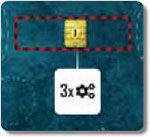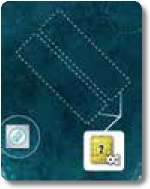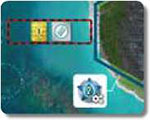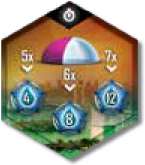
1. Government Contracts

Use these cards to give your game intermediate goals that players can compete for. Shuffle the deck of contract cards and draw 3 at random. Place them on the spaces of the main board at the beginning of the game. Return the remaining cards to the box.
During play, any player may claim a government contract as soon as he or she meets all its criteria. The player keeps the card and immediately gains its benefits. Claimed contracts are not replaced.
2. The Other Side of the Player Boards
The other side of the player boards is for experienced players. The cities have variable numbers of building sites. The black-and-red sites are places where you must pay surcharges - extra resources to build.
They can give you immediate bonuses or increased production. If you decide to try this other side, everyone in the game should use it.
Surcharges
Some sites may have surcharges for building on them (these are not on the side of the player board recommended for your first game). A surcharge is applied after any discounts or cost reductions you may have. For example, if an effect allows you to build on a site for free, you still must pay the surcharge if you choose a site that has one.
The surcharge applies only to building on the site - it does not also apply to upgrading.
Production Multipliers

Production multipliers indicate that the usual level of production is produced multiple times. More specifically, the two-times multiplier shown on the side means that the structure produces the usual amount one extra time.
For example, two upgraded desalination plants at a connected city will normally produce 3 credits and 2 biomatter. If one of them has this multiplier, it will produce an additional 1 credit and 1 biomatter, for a total of 4 credits and 3 biomatter.

As you can see from the example, the multiplier applies to the usual production of an upgrade, but not to any additional production associated with the site.
Multipliers are not applicable outside the Production phase. For example, if a Trial Run allows you to gain the production from an upgraded desalination plant with this multiplier, you gain only 1 credit and 1 biomatter. But during Production, it will produce 2 credits and 2 biomatter.

When you build a city on this site, you must pay a surcharge of 3 steelplast and 3 credits. A connected symbiotic city on this site produces 6 points during Production (instead of 2).
A nonsymbiotic city does not produce points by itself and yields no bonus on this site. The production bonus does not apply to any buildings or tunnels.

When you build a tunnel on this site, you must pay a surcharge of 1 credit. A tunnel on this site produces three times during Production if it is adjacent to a connected city.
This means that a non-upgraded tunnel would produce 3 credits and an upgraded tunnel would produce 3 credits and 3 points.

This production bonus applies only if you have built both tunnels. And, as usual, it applies only if the tunnels are adjacent to a connected city.
In that case, you gain an extra 2 credits when the tunnels produce during Production. This extra production does not depend on whether the tunnels are upgraded.

When you build a tunnel on this site, you must pay a surcharge of 1 credit and 1 steelplast. During Production, the connected metropolis produces an additional 2 points. This bonus does not depend on the tunnel's production.

When you build a city on this site, you must pay a surcharge of 2 science and 2 credits. You immediately gain 6 points, whether the city is connected or not.
3. Sold Game

To play Underwater Cities by yourself, use the advanced side of a player board and the two-player side of the main board. The number of symbiotic domes is not limited in this variant. Set up the game as you would for two players, except do not use this metropolis tile (shown here).
Take three tiles in a non-player color and use them to occupy the rightmost action slot (first slot, if you move around clockwise) of each color. Next time you can occupy second, third etc. action slot of each color. You are going "first", so your marker should start below space 4 of the Federation track. You will not need your player-order track marker.
Gameplay
Play your round as usual. At the end of each round, you take back your action tiles and move all non-player action tiles one space clockwise.
If you did not advance on the Federation track, play your next round with a fourth occupied slot determined by this way:
Flip over the top card of the current era's deck. Add its digits together to get a number.
Starting with the first green action slot (as "1") count around clockwise until you get to that number. Place the new action tile on that slot, if it is empty, otherwise, move the action tile clockwise to the first empty slot.
The 3 non-player tiles of the same color always move one space clockwise. The fourth tile is always placed randomly, and only if you did not advance on the Federation track during the round.
End of the Game
You win if you finish with at least 7 connected cities and at least 100 points. Track your score and try to beat your previous best.
Note: It is not possible to play the solo game with the government contracts.
Continue Reading

